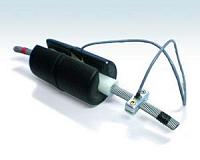 |
London, UK (SPX) May 18, 2011 Bubbles are blocking the current path of one of the most promising high temperature superconducting materials, new research suggests. In a study published in IOP Publishing's journal Superconductor Science and Technology, researchers have examined bismuth strontium calcium copper oxide (Bi2Sr2CaCu2Ox, Bi2212) - one of the most promising superconducting materials capable of creating large magnetic fields way beyond the limit of existing magnets - and found that its capabilities are limited by the formation of bubbles during its fabrication process. Bi2212 is the only high temperature superconductor capable of being made into round wire, providing the preferred flexibility in magnet construction, and giving it potential uses in medical imaging and particle accelerators, such as the Large Hadron Collider in Switzerland. For magnet applications, these wires must exhibit a high critical current density - the current density at which electrical resistance develops - and sustain it under large magnetic fields. This remains a stumbling block for utilising the huge potential of Bi2212 in the magnet technology as compellingly high critical current densities have not yet been achieved. Previous studies have shown that a critical current varies widely between Bi2212 wire lengths - the critical current in wires that were 50 to 200m long was 20 to 50% lower than in 5 to 10cm long samples. This led the researchers, from the Applied Superconductivity Centre and the National High Magnetic Field Laboratory, Florida State University, to conclude that this variability must be caused by the connectivity of Bi2212 grains within the wires. Bi2212 wires, made up of multiple filaments, are fabricated using the powder-in-tube (PIT) method in which Bi2212 powder is packed inside silver tubes and drawn to the desired size. The filaments of Bi2212 powder must firstly be melted inside their silver sheath and then slowly cooled to allow the Bi2212 to reform, greatly enhancing the critical current density. As the processes between the critical melt and re-growth step is still largely unknown, the researchers decided to rapidly cool samples at different times in the melting process in order to get a snapshot of what occurs inside Bi2212 wires. Using a scanning electron microscope and synchrotron X-ray microtomography, the researchers observed that the small powder pores, inherent to the PIT process, agglomerate into large bubbles on entering the melting stage. The consequences of this are major as the Bi2212 filaments become divided into discrete segments of excellent connectivity which are then blocked by the residual bubbles, greatly reducing the long-range filament connectivity, and strongly suppressing the flow of current. The new findings suggest that a key approach to improve the critical current density of the material would be to make it denser before melting. Lead author Dr Fumitake Kametani, of The Applied Superconductivity Centre, Florida State University, said, "Our study suggested that a large portion of bubbles originates from the 30-40% of empty space, inevitable in any powder-in-tube process, which requires particle rolling to allow deformation of the metal-powder composite wire. " "Densification of the filaments at final size - increasing the powder-packing density from 60-70% to greater than 90% - is an excellent way to reduce or eliminate the bubble formation. Various densification processes are now being tested." The published version of the paper "Bubble formation with filaments of melt processed Bi2212 wires and its strongly negative effect on the critical current density."
Share This Article With Planet Earth
Related Links Institute of Physics Powering The World in the 21st Century at Energy-Daily.com
 Finding reserves on the electrical grid
Finding reserves on the electrical gridMunich, Germany (SPX) May 13, 2011 When storms lash northern and eastern Germany, it regularly gets tight in the high-voltage and highest-voltage electrical grids. Electricity from renewable resources has priority on the grid. But, on stormy days in particular, wind turbine systems must be taken offline, because the gird capacities are insufficient. "Currently we are in a situation where we have high inflows from renewable ... read more |
|
| The content herein, unless otherwise known to be public domain, are Copyright 1995-2010 - SpaceDaily. AFP and UPI Wire Stories are copyright Agence France-Presse and United Press International. ESA Portal Reports are copyright European Space Agency. All NASA sourced material is public domain. Additional copyrights may apply in whole or part to other bona fide parties. Advertising does not imply endorsement,agreement or approval of any opinions, statements or information provided by SpaceDaily on any Web page published or hosted by SpaceDaily. Privacy Statement |